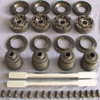quote:
Originally posted by Bosswrench: Stock halfshafts are more than strong enough for almost any modified Pantera engine,
Agreed. It’s an old subject but another example of exaggeration about them being weak and needing replacement. The source of the problem was availability and quality u-joints that gave rise to aftermarket substitutions, usually as a more economical alternative to staying with stockers. It later mutated into a strength myth.
quote:
but stock outer stub-axles DO break under race conditions.
Yah, but what doesn’t?
quote:
OEM '71-'76 OEM stub axles were made of a rather soft mild steel, and many were undersized from the factory so the ball bearing races fit loosely.
Mild steel? I must ask the source of that info? The reason I ask, many years ago when Mark was doing the development work that led to the Williams axles, the problem induced by bearing fit was common enough that they were plating/sputtering original axles because they had tested the hardness and although I forget the figures, they found them to be in hardness regions way North of any mild steel, more in keeping with the typical age hardenable alloys one would expect to find in
forged axles, thus, they used diameter build methods less likely to disturb the original metallurgy. For cost reasons alone, it’s almost a certainty that the original axles were forged. On the materials metallurgy, the splines and threads sure don’t seem to act like mild steel, but this has piqued my curiosity. I have a stock axle. I’ll have to see how hard of a material I need before I can move the surface.
quote:
Resizing the axles by various methods fixes the bearing-fit problem but not the weak metallurgy. New stub axles of EN-300 steel from Wilkinson or billet 4130-axles from Hall (and others) fixes both problems, at a slight cost in heavier unsprung weight (these stub-axles are no longer hollow).
The Williams units have always been available drilled. It’s just an upcharge.
quote:
Gumball tires will sometimes do it in a 3-hr enduro event while at least a few have broken with hard driving on big sticky street tires. Short-duration autocrosses will not.
I certainly don’t doubt such failures have occurred but do question whether it is strength of the stock axle or the mechanism I mentioned in the post above that causes the failure. Out of curiosity, there were factory and privateer cars campaigned for a long time, and as far as I know, long before any aftermarket axle offering. Are you suggesting these were only able to avoid axle failure by being fitted with special non-stock axles?
quote:
FWIW, stub axle breakage always occurs at the large chamfer between the horizontal axle shaft and the vertical wheel flange. I've seen OEM stub axles worn so badly under the outer ball bearing that there was a 1/2" wide x 0.180" deep 'wagon track' under the bearing race, and the axle had not (yet) broken.
Agreed
quote:
Std disclaimer: I personally run welded and resized OEM stub axles and lighter weight Spicer aftermarket halfshafts. One stub-axle mounts std. ball bearings while the other runs my own tapered roller conversion for a long-term comparison. Since July of '98 (a 14-yr period and counting), there has been no detectable performance difference from either bearing type under any driving conditions. Theoretically, the roller bearing will run a bit hotter and soak up a little more power but in a street car, no one can tell them apart.
One tapered roller conversion and one stocker? A 14 yr and ongoing test? You are dedicated to your trade!
quote:
I've never tried CV joint halfshafts in a Pantera, but it seems there's always a weak spot in any design and with these, it's the rubber boots that MUST be intact to hold vital grease inside the joint. Indexing the axles and even denting the pipes to increase boot clearance near the hot exhaust pipes seems crucial.
It’s been discussed in other threads but I’ll repeat it here for completeness of the thread. There’s no doubt that CVs are a superior joint to U-joint. As the name suggests, they are constant velocity and U-joints are not. They will more efficiently transmit power to the ground than a u-joint. How much of the 20% or so that is lost from flywheel to the ground? Dunno. It would just be speculation. The benefit is somewhat diminished on a Pantera because the travel is limited and the initial position does not impart much misalignment. It’s a much bigger deal on buggies and off road vehicles with mucho suspension travel.
While the boots do prevent some loss of lube, it’s not like they are holding the grease in the joint. They are essential in keeping out debris which is critical for their longevity. I’d agree the boots are not very durable. Since Panteras have limited travel, they don’t need much of a boot. If you look close in the pictures in my post above, you can see I have the shorty boots on mine and they are much more durable and shielded from heat. With 180s heat exposure is a moot point.
Other than some subtle gains in power transmission efficiency, the CV assemblies can be made to be lighter in overall and unsprung weight compared to stockers. The CV joints in the side-by-side picture above have had the housings cut down to lighten them. This is a common mod done my many shops. You can gun drill the shafts as well. It all comes at a cost, but those last few pounds always do. They can also potentially provide more exhaust clearance and with high strength cages and treatment of the star/knuckle and housing, handle considerable more power. The ones being used in buggies, sand rails, and drag racing survive incredible amounts of abuse. Is it needed? IMO, definitely superior driveline but hard to say it's the best value for money.
Best,
Kelly





